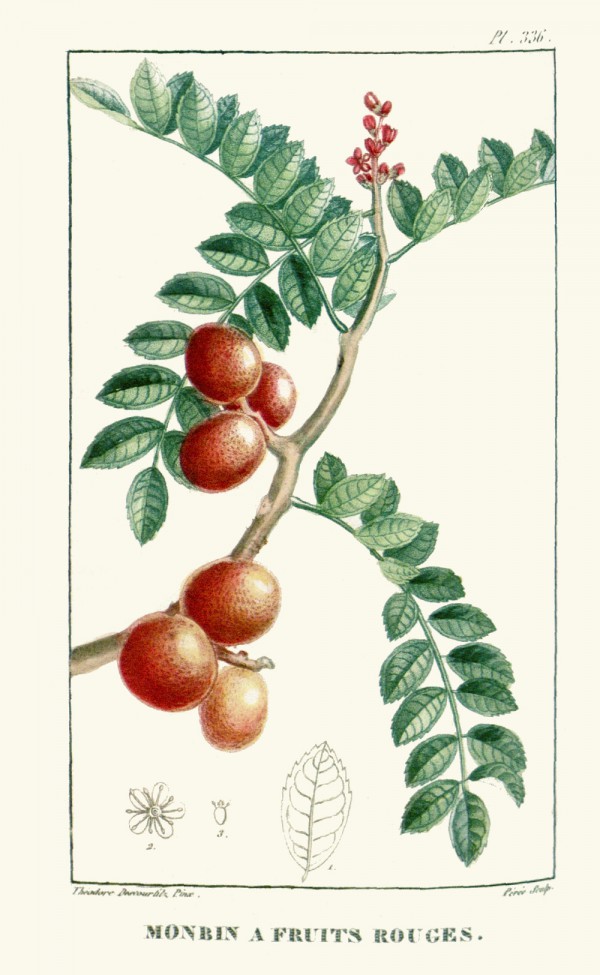Dies ist eine alte Version des Dokuments!
Spondias purpurea L. - syn.Spondias cirouella Tussac - Anacardiaceae
jocote, ciruelo (span.), seriguela, ceriguela (port.), red mombin, hog plum, purple mombin, Spanish plum, Rote Mombinpflaume
Deciduous shrub or small tree, up to 15m tall, native to Central America, the Caribbean and South America (Venezuela, Brazil), also cultivated; leaves alternate, compound, bright-red or purple when young, leaflets 5-19, nearly sessile, obovate to lanceolate or oblong-elliptic; flowers red or purple; fruits purple, dark- or bright-red, orange, yellow, or red-and-yellow, 2.5-5cm, oblong, oval, obovoid or pear-shaped, with small indentations and often a knob at the apex - one of the most popular small fruits of the American tropics.
„The ripe fruits are commonly eaten out-of-hand. While not of high quality, they are popular with people who have enjoyed them from childhood, and they serve a useful purpose in the absence of „snackbars“. In the home, they are stewed whole, with sugar, and consumed as dessert. They can be preserved for future use merely by boiling and drying, which keeps them in good condition for several months. The strained juice of cooked fruits yields an excellent jelly and is also used for making wine and vinegar. It is a pleasant addition to other fruit beverages. In Mexico, unripe fruits are made into a tart, green sauce, or are pickled in vinegar and eaten with salt and chili peppers.“
https://hort.purdue.edu/newcrop/morton/purple_mombin.html
The fruits of Spondias purpurea are highly valued in Ecuador. They are either eaten fresh or processed into various products such as marmalade, wine, and liquor, with promising market potential.
[Economic botany of Spondias purpurea (Anacardiaceae) in Ecuador., Macía, M.J., Barfod, A.S., Economic Botany, 54(4), 2000, 449-458]
Of the 27 substances detected with SPME (PDMS; PA; CAR-PDMS)/GC-MS, the main component was 3-hexen-1-ol. Other alcohols present were e.g. 2-hexenol and hexanol, together with low-chain esters like e.g. ethyl acetate, ethyl crotonate, ethyl 2-methylbutyrate, methyl 2-hexenoate ethyl hexanoate and isopropyl tiglate. Aldehydes like hexanal, nonanal and decanal, and also limonene and diacetyl were detected.
[Augusto, Fabio, et al. „Screening of Brazilian fruit aromas using solid-phase microextraction–gas chromatography–mass spectrometry.“ Journal of chromatography A 873.1 (2000): 117-127]
Main volatile compounds of the fruit pulp were (solid phase microextraction SPME on DVB-CAR-PDMS): hexanal (10.6%), ethyl acetate (8.4%), 3-hexen-1-ol (6.8%), 2-hexen-1-ol (5%), trans-2-hexenal (5%), and hexyl acetate (2%).
[Analysis of volatile composition of siriguela (Spondias purpurea L.) by solid phase microextraction (SPME)., Ceva-Antunes, P.M.N., Bizzo, H.R., Silva, A.S., Carvalho, C.P.S., Antunes, O.A.C., LWT, 39, 2006, 436-442]

Descourtilz M.E., Descourtilz J. Th., Flore médicale des Antilles, ou, Traité des plantes usuelles :des colonies Françaises, Anglaises, Espagnoles et Portugaises., Pl. 336, 1827
Wikimedia.org
